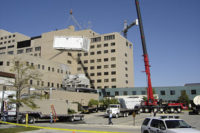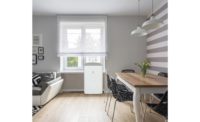Contractors with these views could be overlooking opportunities to provide cost-effective, long-term solutions for their commercial customers’ needs, according to several industry executives. In fact, sales of portable cooling units for long-term or permanent applications represent a significant part of the market for this equipment, ranging from 25 to 40 percent. There are a number of applications and environments where portable cooling units are increasingly being used to provide customers with long-term solutions.
Data Centers and Server Rooms
The most common long-term solution is for data centers, computer rooms, or server rooms. As the need for data storage grows, so does the need for supplemental cooling in those rooms.
For a small room, the portable unit might provide the primary cooling. In bigger data centers, portables can be used for supplemental cooling. And in even bigger server rooms, portables can be used as a fail-safe backup system.
A company that decides to move its server room may not be able to add cooling to the space without extensive work and drilling holes through concrete. In this situation, portable cooling units are a cost-effective and easy solution. Additionally, the contractor also doesn’t have to wrestle with where to place the outdoor unit.
According to Garth Tagge, national sales manager for Spot Coolers, “Some contractors are not aware that these units are designed to run 24/7 for quite a while. They are very rugged and can run years at a time without being shut off.”
Portable units also make sense in similar installations where the equipment puts out a lot of heat. Examples of these include telephone switching equipment rooms or hospital rooms that are adding MRI or CAT scan machines. In all of these applications, portables can be an easy way for a contractor to install a cost-effective, permanent solution for their customers.
Manufacturing Market
Manufacturing is another market segment that matches up well with portable cooling. Portable equipment can be used to reduce cooldown time in manufacturing processes, especially if the process includes injection molding.
“We have seen cases where the cooldown time has been reduced by as much as 94 percent,” said Eddie Stevenson, MovinCool marketing manager. A reduction in cycle time translates into big savings for the manufacturing customer.
The manufacturing environment also lends itself to portable cooling when there is a need for cooling workers in areas of extreme heat where they are relatively stationary. Clark Michel, vice president of Atlas Sales & Rental, cited a recent installation in a steel mill where employees could only operate in an area for 10-minute intervals. With the addition of portable cooling equipment, that interval was extended to 25 minutes.
“In that kind of installation, if you are making 80 widgets an hour and portable cooling ups it to 100, then it’s just a matter of time before the unit pays for itself,” Michel said.
Contractors seeking more commercial clients could make an effort to identify manufacturing companies in their market area with high-heat producing processes. These types of companies could add up to an excellent prospect list for portable cooling.
Office Buildings
Office buildings offer other opportunities for portable cooling. In many cases, building tenants have cooling and heating issues, but they don’t want to invest in new equipment or extensive upgrades if their lease is up in two or three years.
According to Michel, “There always seems to be a corner office with a lot of glass that is either too hot or too cold. Portable heat pump units offer supplemental heating and cooling year-round.”
Portables can also be an energy-saving solution after the office is closed. One or two units can be set to run from 5 p.m. to 8 a.m. so the building owner doesn’t have to run the entire system or cool an entire floor.
Mike Paulson, president of AmeriCool Inc., added, “If you are in a high-rise and want to put in a rooftop or even a split system, you have to go through concrete and it can be very expensive. A portable solution can be one-quarter of the price because you don’t have to go through walls and the labor is so minimal.”
Not only are the installation costs a factor when considering portable versus permanent traditional systems, the tenant or company can take the unit with them when they move to a bigger space or they buy their own building.
“A tenant in a space doesn’t want to gift an HVAC unit to the building owner. If they go somewhere else, they can take the unit with them,” Stevenson noted.
From Temporary to Long Term
When it comes to portable cooling, it may surprise some to discover how often a temporary fix turns into a long-term solution.
“We feel that 70 percent of the time, a rental turns into a sale — and that’s because the customer realizes that this really is a viable solution for their problem,” said Paulson.
Tagge echoed Paulson’s comments, noting, “Once people get used to using them and experience the reliability and efficiency, they begin saying, ‘Why am I using them as a short-term solution? It actually solves my problem and it worked well.’”
Commercial contractors that associate “portable” with “temporary” may be overlooking quick and economical opportunities to solve cooling problems for their customers.
Yet Michel optimistically noted that the perception of portable cooling is changing. “Awareness is way ahead of where it was years ago. The industry will continue to grow as more and more people try it and find out that they really like the equipment,” he predicted.
Publication date: 6/25/2012










